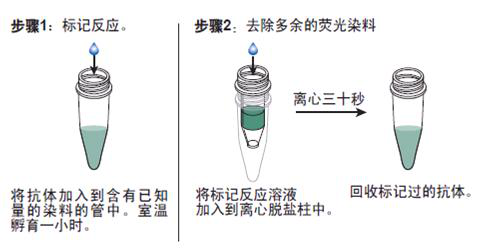
|

| 产地 | 进口、国产 |
| 品牌 | 上海莼试 |
| 保存条件 | Store at -20 °C |
| 货号 | CS11496 |
| 应用范围 | WB=1:100-500 ELISA=1:500-1000 IP=1:20-100 IHC-P=1:100-500 IHC-F=1:100-500 IF=1:100-500 |
| CAS编号 | |
| 抗体名 | Anti-TGF Beta 1/2/3 |
| 克隆性 | |
| 靶点 | 详见说明书 |
| 适应物种 | 详见说明书 |
| 形态 | 详见说明书 |
| 宿主 | 详见说明书 |
| 亚型 | IgG |
| 标识物 | 详见说明书 |
| 浓度 | 1mg/1ml% |
| 免疫原 | KLH conjugated synthetic peptide derived from human TGF Beta 1 (301-350aa) |
抗体的生物素化标记实验要点:
1. 转化生长因子β1抗体说明书 如在反应混合液中有叠氮钠或游离氨基存在,会抑制标记反应。因此,蛋白质在反应前要对 0.1mol/L碳酸氢钠缓冲液或0.5mol/L硼酸缓冲液充分透析;
2.所用的NHSB及待生物素化蛋白质之间的分子比按蛋白质表面的ε-氨基的密度会有所不同,选择不当则影响标记的效率,应先用几个不同的分子比来筛选最适条件;
3.用NHSB量过量也是不利的,抗原的结合位点可能因此被封闭,导致抗体失活;
4.由于抗体的氨基不易接近可能造成生物素化不足,此时可加入去污剂如 Triton x-100, Tween20等;
5.当游离ε-氨基(赖氨酸残基的氨基)存在于抗体的抗原结合位点时,或位于酶的催化位点时,生物素化会降低或损伤抗体蛋白的结合力或活性;
6.生物素还可能与不同的功能基团,如羰基、氨基、巯基、异咪唑基及苯酚基,也可与糖基共价结合;
7.交联反应后,应充分透析,否则,残余的生物素会对生物素化抗体与亲和素的结合产生竞争作用;
8.在细胞的荧光标记实验中,中和亲和素的本底低,但由于链霉亲和素含有少量正电荷,故对某些细胞可导致高本底。
产品订购信息:
英文名称 Anti-TGF Beta 1/2/3
中文名称 转化生长因子β1抗体说明书
别 名 TGFβ1; TGFβ2; TGFβ3; CED; Diaphyseal dysplasia 1 progressive; DPD 1; DPD1; TGF beta 1; TGF beta; TGF beta1; TGF beta2; TGF beta3; TGF-beta 1; TGF-beta 2; TGF-beta 3; TGFB 1; TGFB; TGFB1; TGFB2; TGFB3; Transforming growth factor; Transforming growth factor beta 1; Transforming growth factor beta 2; Transforming growth factor beta 3; Transforming Growth Factor beta.


浓 度 1mg/1ml
规 格 0.2ml/200μg
抗体来源 Rabbit
克隆类型 polyclonal
交叉反应 Human, Mouse, Rat, Dog, Pig, Cow, Rabbit, Sheep, Guinea Pig
产品类型 一抗
研究领域 免疫学 信号转导 生长因子和激素 转录调节因子
蛋白分子量 predicted molecular weight: 12.8/44kDa
性 状 Lyophilized or Liquid
免 疫 原 KLH conjugated synthetic peptide derived from human TGF Beta 1 (301-350aa)
亚 型 IgG
纯化方法 affinity purified by Protein A
储 存 液 0.01M PBS, pH 7.4 with 10 mg/ml BSA and 0.1% Sodium azide
转化生长因子β1抗体说明书 产品应用 WB=1:100-500 ELISA=1:500-1000 IP=1:20-100 IHC-P=1:100-500 IHC-F=1:100-500 IF=1:100-500
(石蜡切片需做抗原修复)
not yet tested in other applications.
optimal dilutions/concentrations should be determined by the end user.
保存条件 Store at -20 °C for one year. Avoid repeated freeze/thaw cycles. The lyophilized antibody is stable at room temperature for at least one month and for greater than a year when kept at -20°C. When reconstituted in sterile pH 7.4 0.01M PBS or diluent of antibody the antibody is stable for at least two weeks at 2-4 °C.
Important Note This product as supplied is intended for research use only, not for use in human, therapeutic or diagnostic applications.
产品介绍 The TGFBeta superfamily is composed of numerous growth and differentiation factors, including transforming growth factors Beta(TGFBeta)1,2 and 3; placental transforming growth factor (PTGFBeta);growth /differentiation factors (GDFs); mullerian inhibiting substance (MIS);bone morphogenic proteins (BMPs); glial cell line-derived neurotrophic factor (GDNF);inhibins or activins (Alpha,Beta-A, Beta-B and Beta-C),Lefty and Nodal. Members of the TGF superfamily are involved in embryonic development and adult tissue homeostasis.
Function : Multifunctional protein that controls proliferation, differentiation and other functions in many cell types. Many cells synthesize TGFB1 and have specific receptors for it. It positively and negatively regulates many other growth factors. It plays an important role in bone remodeling as it is a potent stimulator of osteoblastic bone formation, causing chemotaxis, proliferation and differentiation in committed osteoblasts.
Subunit : Homodimer; disulfide-linked, or heterodimer with TGFB2. Secreted and stored as a biologically inactive form in the extracellular matrix in a 290 kDa complex (large latent TGF-beta1 complex) containing the TGFB1 homodimer, the latency-associated peptide (LAP), and the latent TGFB1 binding protein-1 (LTBP1). The complex without LTBP1 is known as the'small latent TGF-beta1 complex'. Dissociation of the TGFB1 from LAP is required for growth factor activation and biological activity. Release of the large latent TGF-beta1 complex from the extracellular matrix is carried out by the matrix metalloproteinase MMP3. May interact with THSD4; this interaction may lead to sequestration by FBN1 microfibril assembly and attenuation of TGFB signaling. Interacts with the serine proteases, HTRA1 and HTRA3: the interaction with either inhibits TGFB1-mediated signaling. The HTRA protease activity is required for this inhibition. Interacts with CD109, DPT and ASPN.
Subcellular Location : Secreted, extracellular space, extracellular matrix.
Tissue Specificity : Highly expressed in bone. Abundantly expressed in articular cartilage and chondrocytes and is increased in osteoarthritis (OA). Co-localizes with ASPN in chondrocytes within OA lesions of articular cartilage.
Post-translational modifications : Glycosylated.
The precursor is cleaved into mature TGF-beta-1 and LAP, which remains non-covalently linked to mature TGF-beta-1 rendering it inactive.
DISEASE : Defects in TGFB1 are the cause of Camurati-Engelmann disease (CE) [MIM:131300]; also known as progressive diaphyseal dysplasia 1 (DPD1). CE is an autosomal dominant disorder characterized by hyperostosis and sclerosis of the diaphyses of long bones. The disease typically presents in early childhood with pain, muscular weakness and waddling gait, and in some cases other features such as exophthalmos, facial paralysis, hearing difficulties and loss of vision.
Similarity : Belongs to the TGF-beta family.
Database links : UniProtKB/Swiss-Prot: P01137.2
生长因子和激素( Growth Factor and Hormones) TGF是一种多效生长因子,对上皮细胞增值有潜在,可抑制用于许多如:、、、、、等多种的研究。 TGFβ超级家族由为数众多的生长的分化因子组成,包括转移生长因子β1,2和3(TGF β1,TGF β2,TGF β3);胎盘生长因子(PTGF-β);生长/分化因子(GDFs);缪氏抑制物(MIS);骨形态形成蛋白(BMPs);交织细胞元神经生长因子(GDNF);抑制素和活化素(α, β-A,和β-C),Lefty和Nodal。 TGF超级家族成员参与胚胎发育和成体组织体内平衡。TGF-β1抗体与TGF-β2和TGF-β3没有交叉反应。与豚鼠有大部分交叉.

抗体的鉴定:
1)转化生长因子β1抗体说明书 抗体的效价鉴定:不管是用于诊断还是用于,制备抗体的目的都是要求较高效价。不同的抗原制备的抗体,要求的效价不一。鉴定效价的方法很多,包括有试管凝集反应,琼脂扩散试验,酶联免疫吸附试验等。常用的抗原所制备的抗体一般都有约成的鉴定效价的方法,以资比较。如制备抗抗体的效价,一般就采用琼脂扩散试验来鉴定。
2)抗体的特异性鉴定:抗体的特异性是指与相应抗原或近似抗原物质的识别能力。抗体的特异性高,它的识别能力就强。衡量特异性通常以交叉反应率来表示。交叉反应率可用竞争抑制试验测定。以不同浓度抗原和近似抗原分别做竞争抑制曲线,计算各自的结合率,求出各自在IC50时的浓度,并按公式计算交叉反应率。
如果所用抗原浓度IC50浓度为pg/管,而一些近似抗原物质的IC50浓度几乎是无穷大时,表示这一抗血清与其他抗原物质的交叉反应率近似为0,即该血清的特异性较好。
3)抗体亲和力:是指抗体和抗原结合的牢固程度。亲和力的高低是由抗原分子的大小,抗体分子的结合位点与抗原决定簇之间立体构型的合适度决定的。有助于维持抗原抗体复合物稳定的分子间力有氢键,疏水键,侧链相反电荷基因的库仑力,范德华力和空间斥力。亲和力常以亲和常数K表示,K的单位是L/mol。抗体亲和力的测定对抗体的筛选,确定抗体的用途,验证抗体的均一性等均有重要意义。

anti-Rarres2/TIG2/FITC 荧光素标记视黄酸受体应答蛋白2抗体IgGMulti-class antibodies规格: 0.2ml
Nociceptin receptor 孤菲肽受体(痛敏肽受体)(抗原)Multi-class antibodies规格: 0.5mg
信号转导和转录激活因子2抗体 Anti-STAT2 0.2ml
S100A11 英文名称: S100钙结合蛋白A11抗体 0.1ml
EpCAM 英文名称: 上皮特异性抗原抗体 0.1ml
Rhesus antibody Rh Phospho-MAP2 (Thr1620/1623) 磷酸化微管相关蛋白2抗体 规格 0.1ml
Nociceptin receptor 孤菲肽受体(痛敏肽受体)(抗原)Multi-class antibodies规格: 0.5mg
Anti-phospho-STAT5a(pThr694)/FITC 荧光素标记抗磷酸化信号转导和转录激活因子5a抗体IgGMulti-class antibodies规格: 0.2ml
Mouse Anti-rabbit IgG 小鼠抗兔IgG (亲和层析纯化)Multi-class antibodies规格: 1mg
谷氨酸半胱氨酸γ合成酶抗体 Anti-GCS 0.1ml
Donkey Anti-rabbit IgG/Alexa Fluor 555 Alexa Fluor 555标记的驴抗兔IgG 0.1ml
FKBP10 英文名称: 肽基脯酰顺反异构酶FKBP10抗体 0.2ml
Rhesus antibody Rh phospho-Smad3(Ser213) 磷酸化细胞信号转导分子SMAD3抗体 规格 0.1ml
Mouse Anti-rabbit IgG 小鼠抗兔IgG (亲和层析纯化)Multi-class antibodies规格: 1mg
IL-10 人白介素-10Multi-class antibodies规格: 48T
Anti-CHK1 细胞周期检测点激酶1抗体Multi-class antibodies规格: 0.2ml
Rhesus antibody Rh NUP160 核孔蛋白NUP160抗体 规格 0.2ml
Activiated Biotin 活化生物素 5mg
Tumstatin 英文名称: 抑素抗体 0.2ml
Ceruloplasmin 英文名称: 铜蓝蛋白抗体 0.1ml
Anti-CHK1 细胞周期检测点激酶1抗体Multi-class antibodies规格: 0.2ml
MSTN Protein Mouse 重组小鼠 GDF-8 / Myostatin / MSTN 蛋白 (Fc 标签)
BT474 人导管癌细胞
CPB2 Others Mouse 小鼠 Carboxypeptidase B2 / CPB2 人细胞裂解液 (阳性对照)
WI-38人胚肺细胞 WI-38 in human embryo lung cells MEM培养基(GIBCO)+10%FBS
tTA基因修饰的小鼠*癌细胞(B类);Pan02-CAG-tTA-4B3
人成纤维细胞(HPrF)(5×105) 人绒毛膜间充质基质细胞 Human
CM-H017人上皮细胞完全培养基100mL
ICOS Others Rat 大鼠 ICOS / AILIM / CD278 人细胞裂解液 (阳性对照)
主动脉内皮细胞Many types of cells包装:5 × 105次方(1ml)
NB4细胞,人急性早幼粒细胞 绿色荧光蛋白标记小鼠前细胞,MFC-GFP细胞 成纤维细胞培养基FM-sf-prf
MS751(人子宫颈表皮癌细胞) 5×106cells/瓶×2
BEL-7402(人细胞) 5×106cells/瓶×2 CM-R123大鼠角膜成纤维细胞完全培养基100mL 人细胞;Hela
转化生长因子β1抗体说明书 MSTN Protein Mouse 重组小鼠 GDF-8 / Myostatin / MSTN 蛋白 (Fc 标签)
BT474 人导管癌细胞
CPB2 Others Mouse 小鼠 Carboxypeptidase B2 / CPB2 人细胞裂解液 (阳性对照)
WI-38人胚肺细胞 WI-38 in human embryo lung cells MEM培养基(GIBCO)+10%FBS
tTA基因修饰的小鼠*癌细胞(B类);Pan02-CAG-tTA-4B3
人成纤维细胞(HPrF)(5×105) 人绒毛膜间充质基质细胞 Human